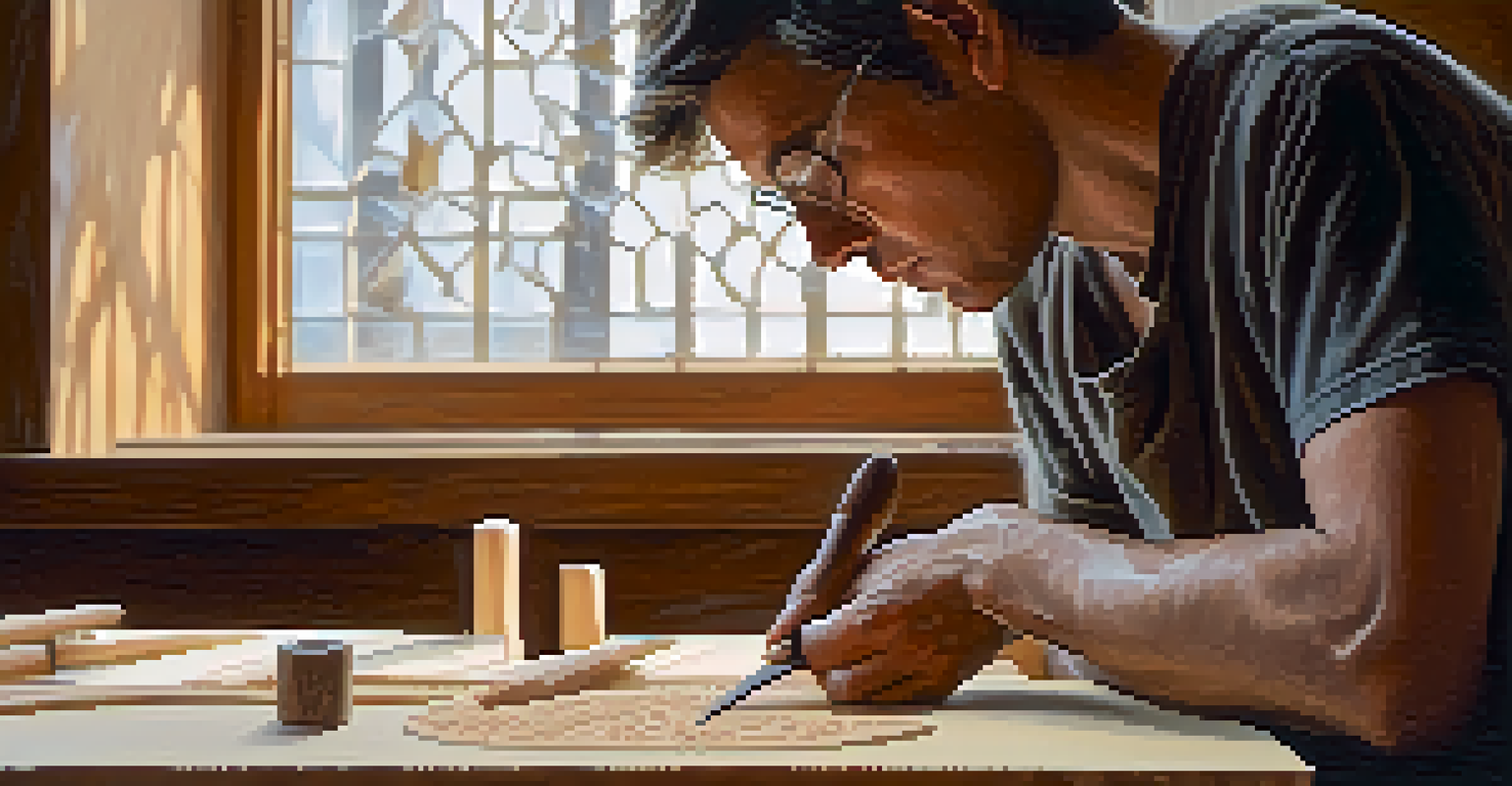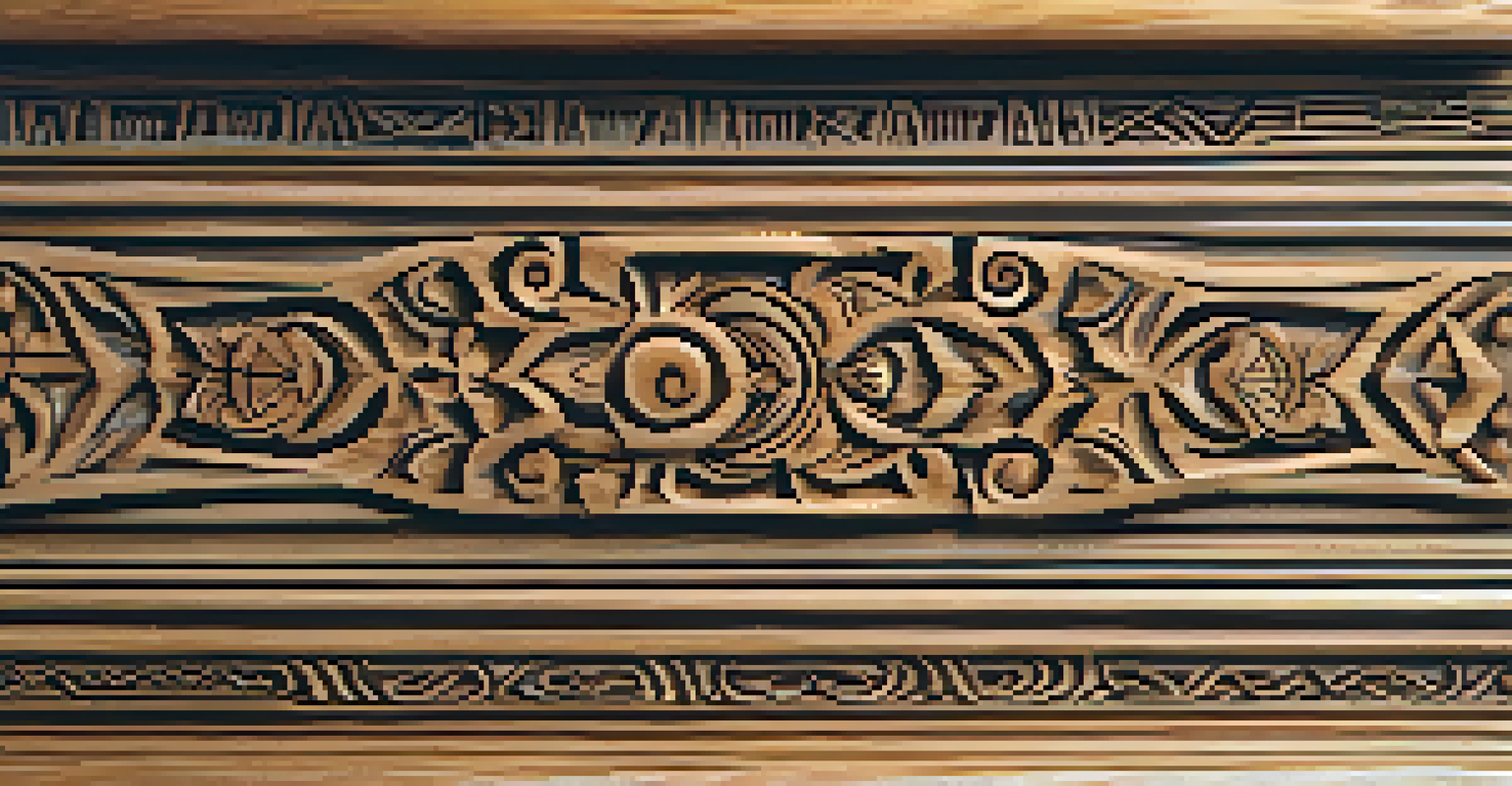From Wood to Mindfulness: The Art of Meditative Carving

Understanding Meditative Carving: What Is It?
Meditative carving is a unique blend of artistry and mindfulness, where the act of shaping wood transforms into a meditative practice. Rather than just a craft, it’s about connecting with the material and allowing creativity to flow freely. As you carve, the repetitive motions can help quiet the mind, similar to how some people find peace in knitting or painting.
The journey of a thousand miles begins with one step.
This practice invites you to slow down, focusing on each cut and curve, which can be incredibly grounding. It’s a way to engage fully with the present moment, making it a beautiful escape from the chaos of everyday life. Just as a sculptor finds form within the stone, you too can discover clarity within the wood.
Ultimately, meditative carving is not just about creating a finished piece; it's about the journey of creation. The experience encourages self-reflection and promotes mental well-being, making it a valuable tool for anyone seeking tranquility in their lives.
The Benefits of Meditative Carving for Mindfulness
Engaging in meditative carving offers numerous mental health benefits. The rhythm of carving can induce a state of flow, where worries and distractions fade away, allowing your mind to relax. This form of mindfulness practice can reduce stress and anxiety, making it an excellent addition to your self-care routine.

Moreover, the tactile experience of working with wood can enhance sensory awareness. Feeling the grain of the wood and observing the changes as you carve can deepen your connection to nature and your surroundings. This sensory immersion not only calms the mind but also fosters a greater appreciation for the materials you use.
Meditative Carving Enhances Mindfulness
Engaging in meditative carving allows individuals to experience mindfulness, reducing stress and fostering a deeper connection to their surroundings.
Additionally, creating something with your hands can boost your self-esteem and sense of accomplishment. Each piece you carve tells a story, reflecting your thoughts and emotions, which can be incredibly liberating. This fusion of creativity and mindfulness allows you to express yourself in a profound way.
Getting Started: Tools and Materials for Carving
To embark on your meditative carving journey, you'll need some essential tools and materials. Start with a basic carving knife, which is often recommended for beginners due to its versatility. A soft piece of wood, like basswood or butternut, is ideal for practice, as it's easy to carve and forgiving for mistakes.
Creativity takes courage.
As you progress, consider investing in a few specialized tools, such as gouges or chisels, to expand your capabilities. Each tool serves a unique purpose, allowing you to create intricate designs and details. Remember, the right tools can significantly enhance your experience and the quality of your work.
Don’t forget about safety equipment! A carving glove can protect your hands, while a sturdy work surface ensures stability as you carve. Setting up a comfortable and safe workspace will help you focus on the meditative aspects of carving without distractions.
Finding Your Inspiration: Nature and Beyond
Inspiration for your carving projects can come from various sources, with nature being a prominent one. Observing the shapes, textures, and patterns in trees, leaves, and landscapes can spark creative ideas. Taking a walk outdoors, you'll likely find plenty of inspiration that resonates with your personal experiences and emotions.
Artistic influences can also be drawn from various cultures, where wood carving holds significant traditional meanings. Researching different styles, such as Japanese or Native American carvings, can provide insight and inspiration for your own work. Emulating these styles can help you develop your unique technique while appreciating the artistry behind them.
Tools and Safety for Beginners
Starting with basic tools and ensuring a safe workspace are essential steps for anyone looking to embark on their meditative carving journey.
Ultimately, inspiration is everywhere; it just requires a keen eye and an open mind. Whether it’s an abstract design, a simple shape, or even the emotional state you wish to express, let your creativity guide you. The more connected you feel to your inspiration, the more meaningful your carving sessions will become.
Setting the Mood: Creating a Mindful Carving Space
Creating an inviting space for your meditative carving practice can enhance your experience significantly. Choose a quiet corner of your home, free from distractions, where you can fully immerse yourself in the craft. Consider adding elements like soft lighting, calming music, or even nature sounds to set the right atmosphere.
Incorporating personal touches such as plants or artwork can also make your space more inspiring. Surrounding yourself with things that bring you joy can elevate your mood and creativity. A well-designed environment not only promotes focus but also encourages a deeper connection to your carving process.
Additionally, consider incorporating mindfulness practices before you start carving. Taking a few moments to breathe deeply or meditate can help clear your mind, allowing you to approach your carving with intention and presence. This ritual can set the tone for a fulfilling and focused session.
Embracing Imperfection: The Beauty of Mistakes
One of the most rewarding aspects of meditative carving is learning to embrace imperfections. Just as in life, mistakes in carving can lead to unexpected beauty and creativity. The unique characteristics of each piece often tell a story and reflect the process of growth and exploration.
Rather than striving for perfection, focus on the experience and the lessons learned along the way. Each time you carve, you’ll discover new techniques and insights that can enhance your skills. This mindset shift can be liberating, allowing you to enjoy the journey rather than fixate on the outcome.
Community Enriches the Carving Journey
Sharing your carving experiences with a community can provide support, inspiration, and foster meaningful connections with fellow enthusiasts.
Moreover, accepting imperfections fosters a greater sense of self-compassion. It reminds us that it’s okay to be human and that every experience contributes to our personal development. By celebrating the uniqueness of your creations, you cultivate a deeper appreciation for both the art of carving and yourself.
Sharing Your Journey: Community and Connection
As you progress in your meditative carving practice, consider sharing your journey with others. Joining carving communities, either online or locally, can provide support and encouragement as you hone your skills. These spaces often foster a sense of belonging and connection, where you can exchange ideas and celebrate each other's growth.
Social media platforms can be a great way to showcase your work and connect with fellow enthusiasts. Sharing your creations not only inspires others but also allows you to receive constructive feedback, enhancing your learning experience. Engaging with a community can deepen your appreciation for the art of carving and the mindfulness it promotes.

Additionally, teaching others about meditative carving can be a fulfilling way to share your passion. Hosting workshops or informal gatherings is a fantastic opportunity to spread the joy of this practice and witness others find their own creative flow. The connections formed through shared experiences can enrich your journey and foster lasting friendships.